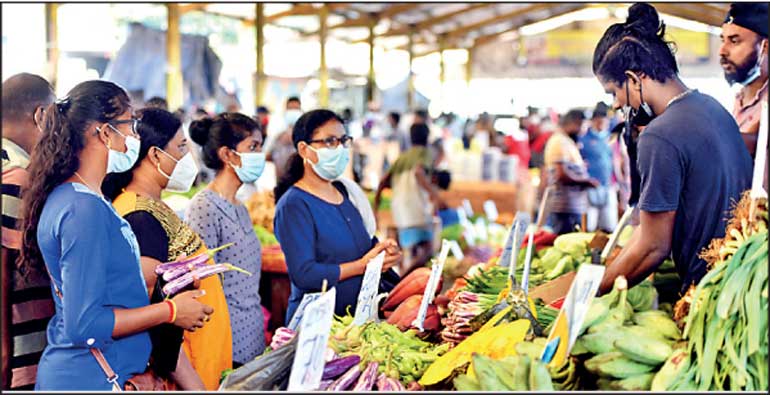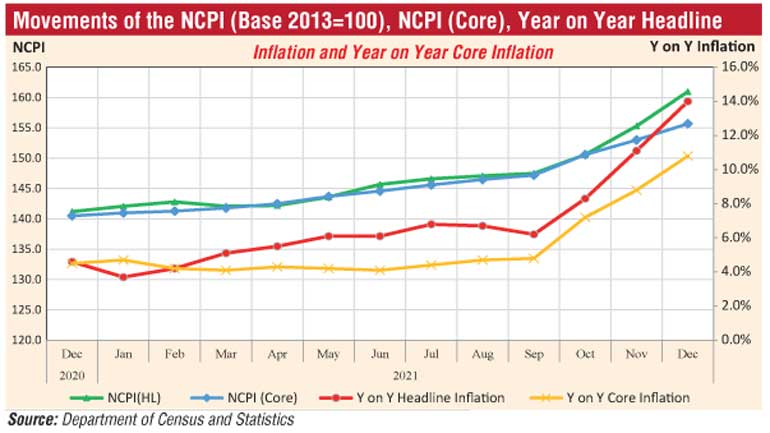Friday Dec 05, 2025
Friday Dec 05, 2025
Saturday, 22 January 2022 01:33 - - {{hitsCtrl.values.hits}}

Soaring food prices are stoking inflation, with the latest data released yesterday by the Department of Census and Statistics (DCS) affirming the former’s continued upward pressure on cost of living.
DCS said headline inflation in December was 14% as against 11.1% in the previous month and said it was mainly due to the higher price levels prevailing in both food and non-food groups.
Inflation of the food group increased to 21.5% in December from 16.9% in November. The year-on-year inflation of the non-food group increased to 7.6% from 6.2%.
DCS said contributions to the inflation rate of December 2021 from the food group and non-food group are 10.0% and 4.0% respectively. Whilst contributions of food and non-food groups to the inflation in December 2020 were 3.4% and 1.2% respectively, resulting in a headline inflation of 4.6%.
Comparing the month-on-month changes, the National Consumer Price Index (NCPI) in December 2021 increased to 161.0 from 155.3 reported in November 2021. This shows an increase of 5.7 index points or 3.7% as compared to November 2021.
The month-on-month change was contributed by increases of index values of food items by 3.0% and non-food items by 0.68% respectively.
DCS said price increases of food items were reported for Vegetables, Rice, Green chillies, Big onions, Potatoes, Eggs, Bread, Coconuts, Chicken, Wheat flour, Milk powder, Biscuits, Red onions, Mysore dhal, Fresh fruits, Coconut oil, Chili powder, Buns, Jak, Dried chillies and Infant milk powder. However, decreases in index values were reported for Green gram, Sugar and Limes.
The increases in index values of non-food groups in December 2021 compared to the previous month was mainly due to the price increases in groups of items ‘Alcoholic Beverages, Tobacco and Narcotics’ (Arrack and Betel leaves), ‘Clothing and Footwear’, ‘Housing, Water, Electricity, Gas and Other fuels’ (Kerosene oil and Firewood), ‘Furnishing, Household equipment, and Routine household maintenance’, ‘Transport’ (Petrol, and Diesel), ‘Restaurants and Hotels’ and ‘Miscellaneous Goods and Services’. Further, very slight price increases were reported in groups of ‘Health’ and ‘Recreation and Culture’.
The price indices of ‘Communication’ and ‘Education’ groups remained unchanged during the month.
Core inflation, which reflects the underlying inflation by excluding volatile items of food, energy and transport groups in the economy as measured by the year-on-year change based on NCPI for the month of December 2021 was increased to 10.8% from 8.8% reported in the month of November 2021.
“We expect continued pressure from food inflation in the near term,” Asia Securities said.
The spike in December in Sri Lanka was contrary to a decline in food prices globally, according to the Food and Agriculture Organisation (FAO).
FAO said world food prices fell slightly in December as international prices for vegetable oils and sugar fell significantly from lofty levels.
The FAO Food Price Index averaged 133.7 points in December, a 0.9% decline from November, but still up 23.1% from December 2020. The index tracks monthly changes in the international prices of commonly traded food commodities. Only the dairy sub-index posted a monthly rise in December.
For 2021 as a whole, averaging across the entire year, the FAO Food Price Index averaged 125.7 points, as much as 28.1% above the previous year.
The FAO Cereal Price Index decreased 0.6% from November, as falling wheat export quotations amid improved supplies following southern hemisphere harvests more than offset firmer maize prices underpinned by strong demand and concerns over persistent dryness in Brazil. For the full year, however, the FAO Cereal Price Index reached its highest annual level since 2012 and averaged 27.2% higher than in 2020, with maize up 44.1%, wheat up 31.3%, but rice down by 4.0%.
The FAO Vegetable Oil Price Index declined 3.3% in December, with weaker quotations for palm oil and sunflower oil reflecting subdued global import demand that may be linked to concerns over the impact of rising COVID-19 cases. For 2021 as a whole, the FAO Vegetable Oil Price Index reached an all-time high, increasing 65.8% from 2020.
The FAO Sugar Price Index decreased by 3.1% from November, reaching a five-month low, reflecting concerns over the possible impact of the Omicron COVID-19 variant on global demand as well as a weaker Brazilian Real and lower ethanol prices. For 2021 as a whole, the FAO Sugar Price Index rose 29.8% from the previous year to its highest level since 2016.
The FAO Meat Price Index was broadly stable in December but over 2021 as a whole, the FAO Meat Price Index was 12.7% higher than in 2020.
The FAO Dairy Price Index was the only sub-index to increase in December, rising 1.8% from the previous month, as international quotations for butter and milk powders increased amid lower milk production in Western Europe and Oceania. Cheese prices declined marginally, reflecting a preference for Western European dairy producers. In 2021, the FAO Dairy Price Index averaged 16.9% higher than in 2020.
